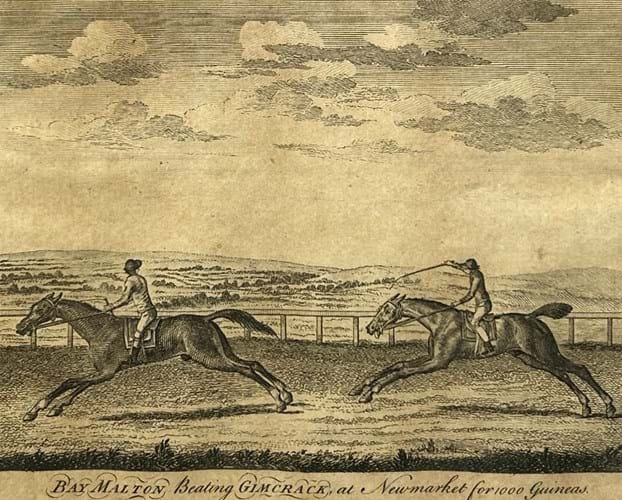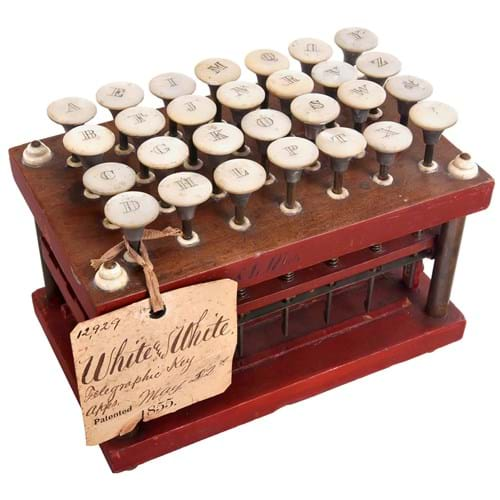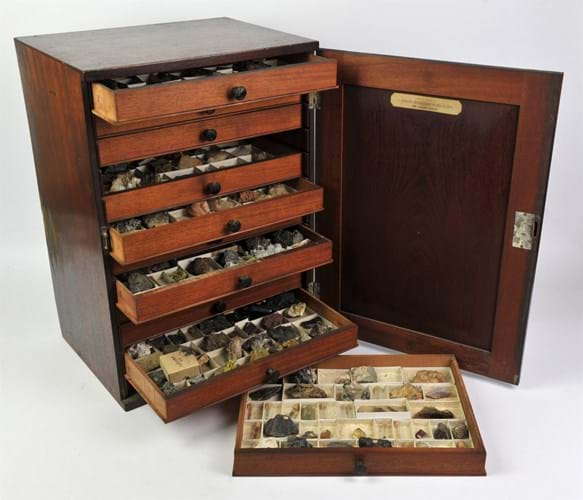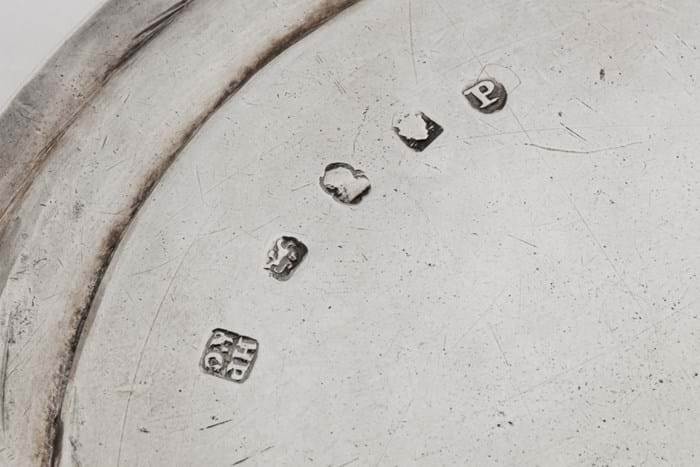1. 1855 telegraph keypad – £44,000
This rare US patent model, offered for sale by German ‘technical antiques’ specialist Auction Team Breker, aimed to change the way messages were passed via the telegraph in the mid 19th century.
Instead of the dots and dashes of Samuel Morse’s code, words could be typed using a keypad containing the letters of the alphabet plus an ampersand and a question mark. The original patent tag, dated May 22, 1855, reads White & White Telegraphic Key Apps while accompanying literature references the patent and the inventors Leroy S White of Chicopee, Massachusetts and Lewis White of Hartford, Connecticut.
White & White’s device appears not to have caught on, but this finely-made mother-of-pearl, mahogany and brass model was the subject of huge competition in Cologne on March 25. Estimated at €3000-5000, it took €50,000 (£44,000).
Developed in the 1830s-40s in the UK and in the US, the telegraph revolutionised long-distance communication. The science was relatively simple – it worked by transmitting simple electrical signals over a wire laid between stations – but the genius was to assign a set of dots and dashes to each letter of the English alphabet that allowed for the transmission of complex messages.
This model was one of many improvements and revisions made to the core technology in the third quarter of the 18th century. Patented in 1855, this was the year before the founding of the Western Union Telegraphy Company, six years before the first transcontinental telegraph line and more than a decade before the first permanent cable was laid across the Atlantic Ocean.
2. William IV mahogany mineral cabinet – £4600
This mahogany 12-drawer cabinet of minerals, rocks and fossils carries the printed trade label reading Arranged and Sold by J. Tennant, Mineralogist by Appointment to Her Majesty, 149 Strand London.
Complete with a catalogue dated December 1835 detailing more than 400 numbered specimens, it had an estimate of £800-1200 at Ewbanks in Surrey on March 23-24 but sold at £4600.
James Tennant, elected a fellow of the Geological Society in 1838, ran a mineral shop at The Strand until 1881. As mineralogist to Queen Victoria, he is best known for supervising the cutting of the Koh-i-Noor diamond for the crown jewels.
3. Rare equestrian engraving – £1200

Bay Malton beating Gimcrack at Newmarket for 1000 guineas, a rare equestrian engraving c.1765, £1200 at Wimbledon Auctions.
Bay Malton and Gimcrack are the two most famous flat racing horses of the 1760s. Bred by Mrs Ayrton of Malton but later purchased by Charles Watson-Wentworth, 2nd Marquis of Rockingham, Bay Malton had a lengthy and lucrative career.
He earned his owner and Yorkshire backers huge sums of money. Raced from the age of four, he lost only two races (both of them in his final two seasons) before retiring as a 10-year-old to stud at Wentworth Woodhouse.
He broke many records (including a course record at York where he ran many times) but one of his most famous victories was recorded against Lord Bolingbroke's celebrated grey stallion Gimcrack. In October 1765 he beat Gimcrack, then considered the very best horse at Newmarket, with relative ease over the Beacon Course. Lord Rockingham was said to have won 9000 guineas on the race.
This was the contest recorded in a very rare engraving offered for sale at Wimbledon Auctions in London on March 27. Titled ‘Bay Malton beating Gimcrack at Newmarket for 1000 guineas’, it was probably printed within a few weeks of the famous race.
No other copies appear to be recorded so this one, guided at just £20-30, ended up taking £1200.
4. Victorian terracotta eagles – £5500
This rare pair of late 19th century terracotta eagles, each standing 2ft 2in (64cm) high have indistinct marks for Blanchard Terracotta London. At garden statuary specialists Summers Place Auctions in West Sussex on March 28 they had a guide of £3000-5000 and took £5500.
Mark Henry Blanchard served his apprenticeship with the Coade Company and around 1839 established his own factory in London. By the middle of the century, he had emerged as the leading manufacturer of terracotta in Britain and was awarded prizes for his exhibit at the Great Exhibition of 1851.
5. York silver sauce boats – £4200
Silver bearing York marks is relatively scarce as the assay office was open only briefly. Most pieces date from the Georgian and Victorian periods when, following an upturn in the fortunes of the silver trade in York, an assay office reopened there in 1776 and remained active until final closure in 1858.
As they catered for a relatively small market (at the time there were also assay offices in Newcastle and Sheffield), many of the silversmiths operated in partnerships.
A pair of George III milk jugs or sauce boats on stands offered at Chiswick Auctions on March 24 had marks for 1802 and the maker Hampston, Prince and Cattle (John Hampston, John Prince and George Cattle were the leading goldsmiths in Georgian York).
It is the survival of the stands that makes them so unusual. The crest engraved to both jugs and stands is most likely for the Sykes family of Sledmere. A baronetcy was created in 1783 for Reverend Mark Sykes (1711-83) with these pieces perhaps made for Mark Masterman Sykes (1771-1823) or his younger brother, Sir Tatton Sykes, 4th Baronet (1772-1863).
Estimated to bring £500-800 they took £4200 from a buyer in York.










